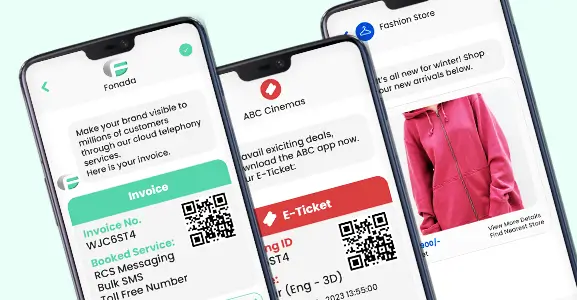Conversational AI Introduction
Customers now want digital assistance, instant gratification, quick responses, and customized experiences from the businesses they support. They want to be treated and heard as unique individuals, not as cases or tickets.
In such a scenario, modern companies must provide omnichannel, personalized, and real-time Customer experiences for which existing customer communications tools are ineffective. Here, conversational AI comes into the picture.
Conversational AI enables machines to understand and analyze human language inputs and answer in a way similar to humans in context and flow. Let’s discuss deep conversational AI in this post.
What Is A Conversational AI?
Conversational AI enables automatic human-computer conversation and messaging and enables organizations to develop chatbots and virtual assistants.
Conversational AI algorithms can communicate like humans by identifying user intent, understanding the purpose of speech or text, and imitating human speech.
The ultimate objective of conversational AI is to be indistinguishable from humans.
Natural Language Processing
Conversational AI uses NLP, as well as other AI algorithms, to understand the contextual dialogue.
Natural Language Understanding (NLU)
It focuses on deciphering the meaning in the user’s words without regard to how it’s stated, enabling the AI to understand the user’s intent despite grammatical errors or shortcuts.
Natural Language Generation (NLG)
AI generates a response in natural language that the user easily understands.
Machine Learning
Through machine learning, the AI determines the correct response depending on the user’s intent.
How Does Conversational AI Work?
Generating Input
When the user provides a query, the procedure begins. This input can be from a text-based or voice-based medium.
Analysis Of Input
The platform’s machine learning layer uses NLU and NLP to break text into smaller parts and extract meaning.
Once the machine has text, artificial intelligence in the decision engine analyzes the information to understand the query’s intent.
Generation Of Output
AI will match the user’s question with a relevant response. It will communicate with the user through natural language generation (NLG).
Before creating the result, the AI interacts with integrated systems to analyze the user’s profile and previous interactions. It helps narrow down the response based on client information and adds a degree of personalization to the answer.
There is a high probability that the AI will be unable to map the intent to the database. In such cases, the computer transfers the conversation to an agent.
The AI’s answer converts speech from text. The user hears the Voice AI response in real-time.
Reinforcement Learning
The AI refines its next response based on the user’s satisfaction with the previous response.
Businesses get a rich trove of data with variances in purpose and utterances to further train the AI with each interaction. Over time, the user obtains quicker and more accurate replies, improving their interaction with the machine.
What Is An Example Of Conversational AI?
Following are the example for conversational AI
Apple’s Siri
Siri uses AI to do tasks, answer questions, and make recommendations.
First released in 2011, Siri has become a vital element of Apple’s ecosystem, helping consumers get the most out of their devices.
Siri lets iPhone users send texts, schedule appointments, and get directions without touching their phones.
Siri is continually learning, so it gets better with every use.
FAQ Bot
FAQ Bots are a sort of chatbot that answers commonly asked questions.
FAQ Bots offer customer help, technical support, or product information. They’re programmed with a set of FAQs to respond to and may learn new ones over time.
We may use these bots on websites, chat applications, or voice assistants such as Alexa or Siri. FAQ Bots may help customers or users find information and save customer support staff time.
Google Assistant
Google Assistant lets users plan appointments, set alarms, and check the weather by speaking.
On smartphones, tablets, and smart speakers, Google Assistant is available.
Google Assistant can control lights and thermostats. It can also access maps and weather forecasts online.
Google Assistant regularly adds new features and integrations. Google Assistant is quickly becoming one of the world’s most essential tools.
Amazon Alexa
Amazon Alexa controls Echo, Fire TV, and other Amazon devices via voice commands. Alexa sets alarms, answers questions, calls, plays music and messages and controls smart home devices.
What Are The Benefits Of Conversational AI
Increase Efficiency
Conversational AI reduces customer service expenses and boosts work efficiency. It may improve resource allocation and replace human workers. Conversational AI lets people and computers work together smoothly. It lets humans do higher-value tasks while bots do lower-value tasks. Conversational AI may boost efficiency in sales and marketing, IT, finance, accounting, and Human resources.
Customers may interact with conversational AI outside of business hours. It might be with customers who are buying or who need help. Conversational AI-powered bots can function quicker than humans, ensuring buyers don’t lose interest while waiting for transaction details. Conversational AI can manage countless consumer contacts simultaneously.
Conversational AI saves time by handling simple customer and client interactions. Transforming all standard needs to intelligent digital employees using conversational AI reduces customer wait times, and clients who need human interaction get it quickly.
Cost-Cutting
Every department in a 21st-century business may profit from Conversational AI, particularly if they rely heavily on B2C and customer interaction. Customer Contact Centers connect with Conversational AI. Customer contact centers may use conversational AI for remote phone and VOIP management, outbound calls, callbacks, surveys, and bots assisting individuals in real time.
Conversational AI may reduce the cost of collections, contract management, contract renewals, claim processing, expense tracking, billing, and contract inquiries. HR departments may use Conversational AI for screening, onboarding, time tracking, off-boarding, vacation and holiday tracking, and benefits processing.
Conversational AI can help sales and marketing. We may use IPA and CAI for CRM lead and prospect entry, customer setup, social media monitoring, and answers. Operations departments may use conversational AI for customer reminders, appointment confirmations, service call confirmations, scheduling, and data collection. Finally, password resets, website bots, and more may reduce IT costs using conversational AI.
Data
Conversational AI helps businesses get better data. Conversational AI will collect vast volumes of consumer and client data. We may use all of it for analysis and future decisions, and better and greater data collecting improves analysis, decision-making, and customer experiences. After collecting, saving, and analyzing a client’s data, the company may give a more personalized and better customer experience.
Improve Customer Service
AI automates customer engagement, and businesses may swiftly respond to customer communication increases by adding bots or digital workers. We can use Conversational AI to create digital virtual assistants, and conversational AI enables a digital assistant for any human work. Digital assistants make humans more valuable, focused, and productive. Collecting and prescreening information before a business contact boosts productivity.
A digital assistant can answer 70-80% of consumer questions or requirements. Conversational AI is popular in call centers. Currently, well-designed contact centers use 70% bots and 30% humans, but this will rise to 90% bots and 10% humans in the future. When Conversational AI systems are attractively designed and quick and efficient, people will welcome the change.
Conversational AI leverages natural language processing libraries. NLP tools aren’t just in English; conversational AI helps businesses support more languages. Language differences don’t impede or limit customer service interaction. It may attract new consumers.
NLP’s quality and capabilities are improving quickly, as is its ability to respond to human interaction and behavior. Conversational AI-powered bots may also work more hours than humans.
They can work 24/7 without breaks, and conversational AI enables customer engagement 24/7 in contact centers and social media. Conversational AI may make clients feel cared for since a business is more available when done effectively.
What Are The Conversational AI Use Cases?
Conversational AI use cases are:
Telecommunications
Telecoms are increasing their service areas and user bases. It is good news for them, but they get many customer inquiries that need 24-hour assistance. Next-generation cognitive bots can give advanced, human-like help at scale and in varied scopes.
Retail
Retail and e-commerce are increasingly using conversational AI.
Applications Include:
Recommendations
Conversational AI may help retailers recommend products based on customer interactions.
Multichannel Integrations And Scalability
Conversational AI can have many conversations simultaneously without a human agent.
It may enhance conversions and sales and minimize costs from traditional communication methods like phone calls.
Inventory Tracking
Conversational AI can automatically track inventories to keep customers updated on availability.
Customer Data Insight
Digitally recording customer conversations. It removes the need to record every discussion or interaction. Your businesses may gain insight into their products and services by analyzing search queries.
Healthcare
Conversational AI In Healthcare Has The Following Use Cases:
Medical Scheduling
A conversational AI platform can help people schedule appointments by providing appointment information. It helps patients manage paperwork to simplify medical processes.
Therapy
Another healthcare conversational AI tool fills a gap between practitioners and patients. As a result, healthcare institutions may give 24-hour service, helping human therapists.
Virtual Patient Assistant
Virtual agents can help them understand difficult medical topics. It frees up medical assistants to conduct more pressing work, reducing stress.
Data Collection
Pharmaceutical businesses may use conversational AI to collect patient or consumer input via focus groups or surveys. It does not need an interviewer, saving time and money on hiring human data collectors.
Diagnosis
Conversational AI tools may diagnose health issues online by simply asking questions. Then it may learn from patients’ answers to get insight into their health conditions without a medical assistant.
Internet Of Things (Iot) Devices
Conversational AI-enabled devices that use speech recognition are helping in modern homes.
These devices include Google Home, Amazon Echo, and smart device assistants like Apple Siri and Google Assistant.
Some conversational AI applications in this field include:
- Controlling home appliances through Amazon Alexa.
- Monitoring any device that can call or send messages to the user.
- Amazon Alexa lets you order food. AI bots understand your tastes so that they can suggest services and products.
Finance And Banking
Conversational AI has helped banks decrease costs, automate functions, and enhance customer experience.
Here are some finance and banking use cases of conversational AI:
- A virtual assistant, voice assistant, or AI bot may check user balances and perform transactions. Automatic Speech Recognition can recognize phrases or keywords that may indicate fraud.
- Conversational AI can detect abnormalities in everyday behavior that point to fraud.
- Another application of conversational AI in banking is accessing and analyzing customers’ spending habits or bank accounts to assist them in deciding how to spend their money.
- In banking, conversational AI may automate repetitive tasks. Automation improves efficiency and resolution, which is crucial in banking.
Customer Service
Customer service extensively uses conversational AI. AI-powered virtual assistants save businesses money by automating customer support.
Let’s explore how AI may help customer service:
Billing Support And Complaint Management
The conversational AI technology that helps customers via voice may also help through SMS.
Helping Agent
Conversational AI solutions like virtual assistants may support customers behind the scenes.
During real-time human interactions, AI may populate the agent’s screen with relevant customer information and help co-pilot a call.
Reservation Or Appointments
Conversational AI may handle reservations or appointments for your business.
Find Merchandise And Recommend Products
An AI chatbot may help customers find products faster by extracting database information. Chatbots may recommend similar products to enhance the customer experience.
Order Management
A conversational AI platform can automate purchasing confirmation and send customers order updates.
Customer Satisfaction Surveys
Customers will choose an AI or conversational AI chatbot over a human agent to rate their satisfaction. The conversational AI may prompt feedback and provide accurate consumer experience insights.
Travel
An intelligent virtual assistant may help a customer book a flight and answer travel FAQs.
Sales And Marketing
Many customers prefer self-service technology over human sales agents. Self-serve customers traditionally gain convenience and speed but lose personalized recommendations. However, conversational AI gives them all.
Real Estate
Real estate is also thriving with conversational AI tools. Here are conversational AI applications in real estate:
Handling Initial Conversations
A conversational AI bot may relieve human agents of a load of engaging in initial-level customer conversations. These bots can contact more leads and manage more consumers, helping you to understand what each customer wants.
Manage Multiple Conversations
Conversational AI can connect with numerous prospects at once, enabling you not to miss a potential client.
Potential Customers Filtering
When integrated with CRM, a conversation AI system may filter customers with a greater chance of a conversion.
Conversational AI can identify ready customers with regular calls and lead nurturing.
Lead Generation
Real estate lead generation is crucial. Success relies on how fast and effective we manage properties. It involves identifying, nurturing, and closing leads.
Conversational AI has made this function more accurate, efficient, and error-free.
Insurance
Customers dropping out mid-application or renewing contracts are insurance company challenges. Conversational AI can help companies resolve these problems.
The media-friendly interface of the conversational chatbot lets users provide ID proof, health declaration forms, income statements, and signed proposal forms.
Logistics
Low-level queries inundate logistics companies. Order statuses, refunds, cancellations, and returns clog support channels.
Instead of having service representatives answer phones and email 24/7, companies may use a conversational AI platform to improve customer and employee experience.
SaaS
Conversational AI changes how users interact with SaaS. Instead of clicking through menus or buttons, users may now talk to their software. Using voice recognition or chatbots may do this.
SaaS providers may tailor user experiences using conversational AI. Service providers may customize the user’s experience by understanding their needs, increasing user engagement, and encouraging software use.
Conversational AI can help gather customer data. This data may help providers make their software more user-friendly, boosting the SaaS experience.
Data Collection
Conversational AI isn’t only about customer interaction. It may help businesses analyze and gather data, giving a competitive advantage.
This data may help you understand consumers and identify process flaws.
What Distinguishes Chatbots From Conversational AI?
Conversational AI Vs Chatbot
Conversational AI refers to AI-driven communication technologies like virtual assistants and chatbots. Conversational AI technologies recognize the voice and text inputs, mimic human interactions, and enhance conversational flow.
Chatbots simulate human conversations to serve consumers better. Others use AI and NLP to understand user questions and give automated responses in real-time.
What Is The Future Of Conversational AI?
Conversational AI is rapidly expanding. The conversational AI market was $6.8 billion in 2021 and is forecast to reach $18.4 billion by 2026.
This rise is partly due to digitized consumer interactions, technological innovation, and changing customer requirements.
More companies are implementing AI-powered customer service solutions to decrease costs and meet customer needs. Chatbots and intelligent virtual assistants will be the most popular AI-powered solutions in the next 2-5 years.
Conclusion
Conversational AI is rising in popularity, and for a good reason. Businesses use AI to enhance customer support, marketing, and overall consumer experience.
Customers care more about every interaction they have with a company. There is a demand for rapid, effortless resolutions across more channels. Even a bad experience may prevent a customer from doing business with a company again. Conversational AI helps companies scale customer experiences by resolving simple questions in seconds. So, agents are only necessary for complex, unique, or sensitive requests.

Dec 11, 2024
Top Contact Center Optimization Tools For 2024
“A thriving business knows how to fetch maximum output from limited resources by optimizing ca... Read More
Nov 13, 2024
What Is Brand Communication? CPaaS Role Explained
Did you ever wonder why some advertisements grab your attention instantly, while others do not? The... Read More
Nov 01, 2024
What Is Automated Messaging And How Does It Work?
Automated messaging or text automation empowers businesses and marketing professionals to connect wi... Read MoreLatest Updates
From Fonada
Industry Insights, Trends, Innovations, Updates, and Case Studies from Industry Experts
View
Customer
Reviews
Discover why our customers love us - read their authentic and heartfelt reviews!
View
Case
Studies
Explore real-life scenarios, offering analysis, and solutions to practical challenges
View
Convert Leads Into Sales With Fonada
Trusted CPaaS Solution Provider








